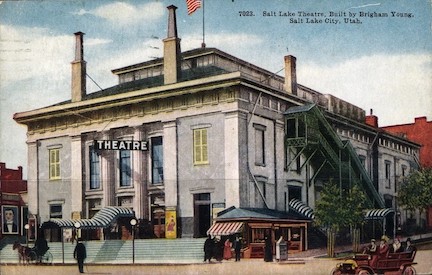Salt Lake Theatre
One of the best theaters of the 1800s in the West was the Salt Lake Theatre. Theater in Utah was supported by members of The Church of Jesus Christ of Latter-day Saints throughout Utah territory.
- Even before the Latter-day Saints migrated to Utah, they staged plays and elaborate pageants in Nauvoo, Illinois, in the early 1840s. Brigham Young himself played a Peruvian high priest in the play Pizarro staged there. As soon as the Mormons felt comfortably settled in Salt Lake City, they again turned to drama for entertainment. In the fall of 1850 the Deseret Musical and Dramatic Association, which included the Nauvoo Brass Band, was formed. Performances were held at the Bowery on the temple block.[1]
“In 1852 the Musical and Dramatic Association reorganized as the Deseret Dramatic Association, with Brigham Young as an honorary member. The Social Hall was erected and served as a principal place of amusement from 1852 to 1857.”[2]
Brigham Young decided to build a first-class theatre, and excavations on the corner of 100 South and State streets began in July 1861. William H. Folsom was the architect of the Doric exterior, and E.L.T. Harrison, an architect from London and recent convert, modeled much of the interior after the London Drury Lane Theatre. Building supplies came from the now-disbanding Camp Floyd and the wreckage of government wagons on the trail.
The Salt Lake Theatre was completed in March 1862 at the cost of $100,000. It was the largest structure yet built by the Saints at the time.
At the opening, Daniel H. Wells offered a dedicatory prayer and Brigham Young spoke. Over 1,500 people crowded the theater for the opening, and many continued to come for later performances. The theater drew in both Latter-day Saints and non-members. “Great actors of the time began to come to Salt Lake City because of the quality of the theater and the sophistication of the audiences.”[3] Actor and producer Henry Miller called the theater the “cathedral in the desert.” "Virtually every star of the American stage appeared there including Sarah Bernhardt, Ethel, John, and Lionel Barrymore, P.T. Barnum, Maude Adams, Edwin Booth, "Buffalo Bill" Cody, Al Jolson, and Lillian Russell.”[4]
Utah was placed on the national theatrical circuit after the completion of the transcontinental railroad in 1869 and the New York booking agencies controlled the theater’s shows.
The Salt Lake Theatre was renovated in 1873 and the exterior was made to look like an old European opera house. In addition to updated décor, the renovation provided more storage space, larger dressing rooms, and the addition of rehearsal space. New advanced stage equipment provided amazing acoustics and decorative art created an elegant environment.[5]
After World War I, the motion picture business was extremely popular and with its popularity waning, the Salt Lake Theatre accumulated debt. President Heber J. Grant sold the theatre to Mountain States Telephone and the building was demolished in 1928.[6]
However, the Pioneer Memorial Theatre, intended to be the modern counterpart of the old Salt Lake Theatre, is located on the University of Utah campus. The Pioneer Memorial Museum, a full-scale reproduction of the original, is located near the state capitol in Salt Lake City and houses the collection of the Daughters of Utah Pioneers.
